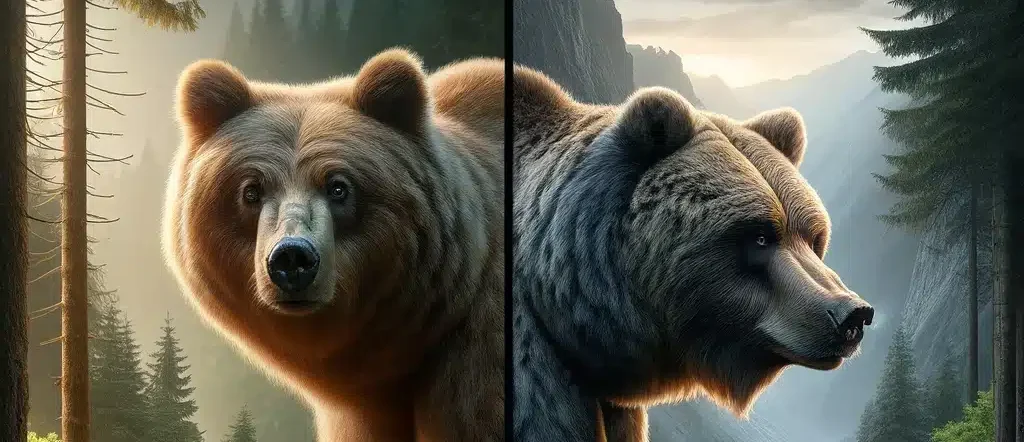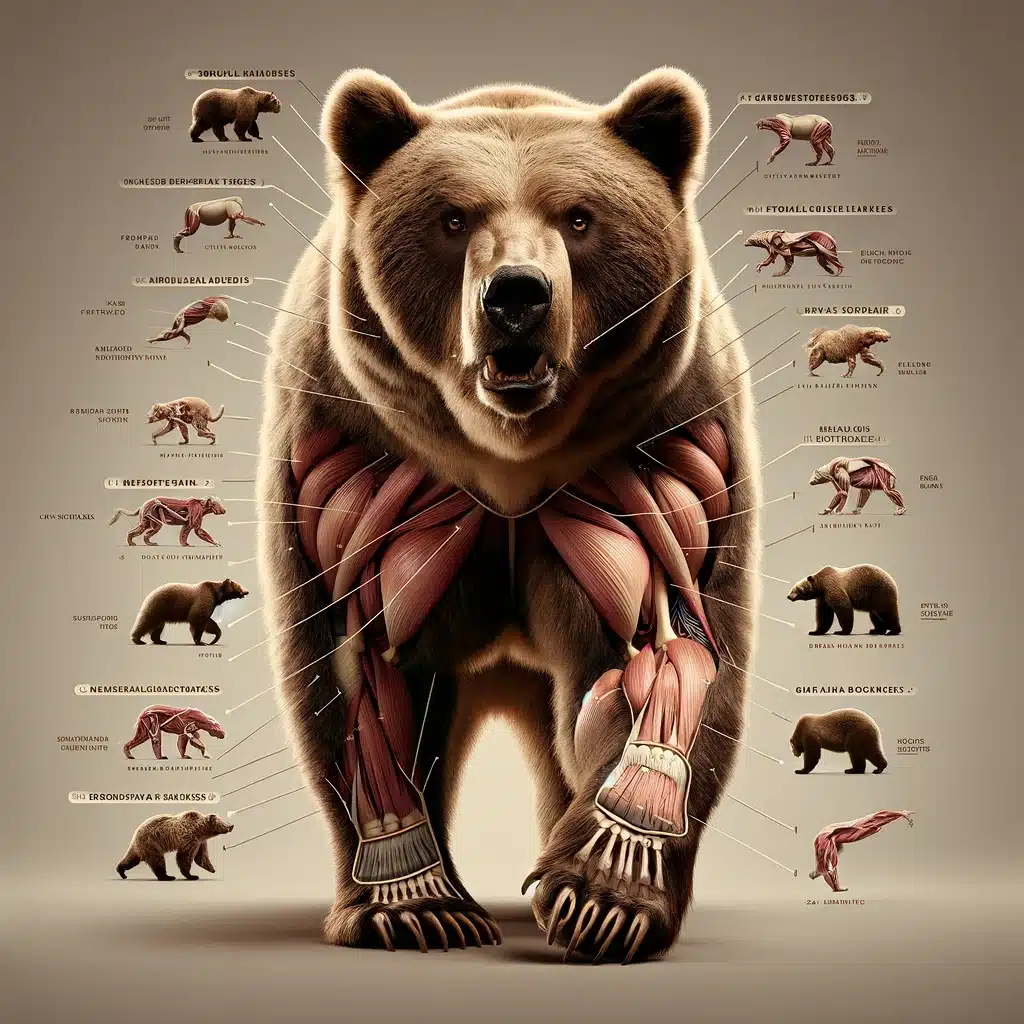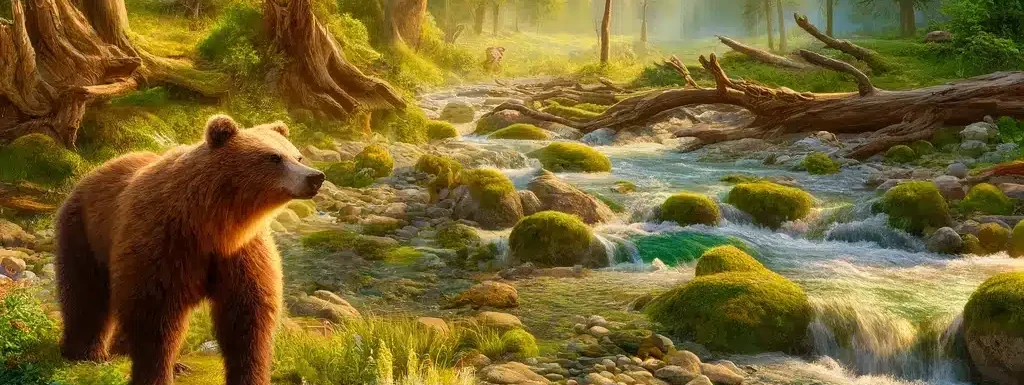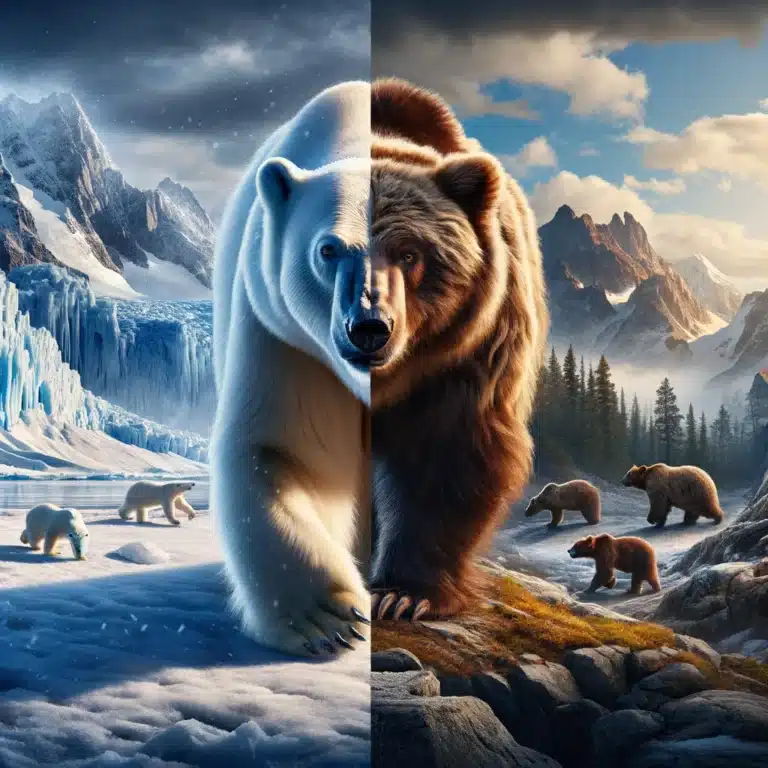Have you ever looked at a picture of a grizzly bear and thought, ‘Hey, that looks an awful lot like a brown bear?’ You’re not wrong! The world of brown bear vs grizzly bear can be confusing, shrouded in myths and misconceptions. But fear not, fellow wildlife enthusiast! This blog post is here to peel back the layers and reveal the fascinating truth about these giants of the wild.

The North American wilderness echoes with the power of the brown bear. But wait, isn’t that a grizzly bear? The confusion surrounding these two giants can leave even the most ardent nature lovers scratching their heads.
Bears and brown bears share many similarities and differences, including their genetic relationship, physical characteristics, habitats, diets, behaviors, and roles as umbrella species in the ecosystem.
Are brown bears and grizzly bears entirely different species? Or is there more to the story? Grizzly bears, scientifically called grizzly bears, belong to the species Ursus arctos.
In this blog post, we’ll embark on a journey to untangle the ursine mystery, delving into the scientific classification, physical characteristics, and habitat preferences of these awe-inspiring creatures.
By the end, you’ll be a brown and grizzly bear expert, ready to impress your friends with your newfound knowledge.
Ursine Unveiling: Classification and the Subspecies Shuffle
Brace yourselves for a plot twist – brown bears and grizzly bears aren’t separate species! Here’s where things get interesting. The brown bear, scientifically known as Ursus arctos, is an umbrella term encompassing a variety of subspecies.
They all fall under the same species, Ursus arctos. Think of it like a family tree, with the brown bear as the proud patriarch and various subspecies branching out from it.
One of these fascinating offshoots is the grizzly bear, classified as Ursus arctos horribilis. Yes, that impressive creature roaming the mountains of North America isn’t a completely different species but rather a close relative within the brown bear family.
Think of it like a regional cousin, sharing a strong family resemblance but with some unique adaptations to its specific environment.
But the brown bear family tree doesn’t stop there. The mighty Kodiak bear, renowned for its immense size, is also a recognized subspecies of the brown bear (Ursus arctos middendorffi). These gentle giants, found on Kodiak Island off the coast of Alaska, are the largest land predators in North America.
To visualize this fascinating family structure, imagine a branching tree. At the top sits the majestic brown bear, and below it sprout various subspecies like the grizzly bear and the Kodiak bear, each with its own specializations and geographic distribution.
This classification system helps us understand the diversity within the brown bear species while acknowledging their shared ancestry.
Beyond the Fur: A Look at Physical Traits

So, we’ve established that brown bears and grizzly bears are closely related members of the same Ursus arctos family. But surely, there must be some physical distinctions to tell them apart; there can be some subtle differences, but overall, they share a remarkable resemblance.
Both brown bears and grizzly bears boast a powerful build, with robust bodies and impressive claws perfect for digging and foraging. Their fur can range in color from light brown to dark brown, with grizzliesbrowniting a distinctive “grizzled” appearance due to lighter-tipped fur on their shoulders and back (though this isn’t always the case).
It is smaller than the brown and grizzly bears, with different physical traits and habits.
Here’s where things get interesting: size variations can offer hints about subspecies. While brown bears and grizzlies are undeniably large, Kodiak bears reign supreme.
These coastal giants can reach staggering weights exceeding 1,500 pounds, dwarfing their inland grizzly cousins who typically tip the scales between 400 and 900 pounds. Brown bears generally exhibit a wider range in size depending on their subspecies and location.
However, focusing solely on size or fur color to differentiate brown bears and grizzlies can be tricky. A more reliable indicator might be facial structure. Grizzly bears often have a slightly dished facial profile, with a dip between the eyes and the tip of the nose. Brown bears, particularly coastal varieties, may have a straighter facial profile.
It’s important to remember that these are just general tendencies, and there can be exceptions. The key takeaway is that brown bears and grizzly bears share a strong physical resemblance, with some subtle variations hinting at their specific subspecies.
Habitat Hues: Where the Coastal Brown Bears Reign

With its various subspecies, the brown bear boasts an impressive range worldwide. Imagine these giants roaming diverse landscapes, from towering mountains to lush forests and windswept coastlines.
Brown bears, in all bears’ dietlory, are incredibly adaptable. They can be found in:
Mountainous Terrains
Grizzly bears are the quintessential mountain dwellers, thriving in the rugged peaks of North America, from Alaska and western Canada down to the Rocky Mountains. Inland grizzlies, in particular, inhabit these mountainous areas, differing from coastal brown bears in their diet and behavior towards food competition.
Dense Forests
Brown bears, particularly interior populations, find refuge in the cool embrace of evergreen and mixed forests, where they can forage for berries and other food sources.
Coastal Regions
Like their Kodiak kin, Coastal brown bears reign supreme along the Pacific coast. These regions offer an array of key dietary components for these formidable hunters.
In contrast, grizzly bears have a more restricted range. They primarily inhabit the mountainous regions of western North America, where they face a harsher climate and rely on a wider variety of food sources than their coastal cousins.
Habitat loss and fragmentation are major threats to brown and grizzly bears. Human encroachment and development can disrupt these vital ecosystems, impacting food availability and migration patterns.
By understanding the habitat preferences of brown bears and grizzlies, we gain a deeper appreciation for their ecological roles and the importance of conservation efforts to protect their wild homes.
Blurring the Lines: Fact vs. Fiction

By now, you’ve likely shed the confusion surrounding brown bears and grizzly bears. Let’s address some lingering misconceptions:
Myth: Brown bears and grizzly bears are completely different species.
Fact: Grizzly bears are a subspecies of the brown bear (Ursus arctos horribilis).
Myth: There’s only one type of brown bear.
Fact: Brown bears encompass various subspecies, including Kodiak bears and grizzlies, each with unique adaptations.
Myth: You can easily tell a brown bear from a grizzly bear by fur color alone.
Fact: Fur color can vary within both brown bears and grizzlies. Facial structure and size can offer better clues, but there can be exceptions.
Myth: Color is a reliable key in differentiating black and brown bears.
Fact: Black and brown bears have many color phases, ranging from dark brown to light blond. Size, shoulder hump, and claw length are more reliable indicators.
Myth: Polar bears are just white-brown bears.
Fact: Polar bears diverged from brown bears and adapted to their Arctic environment, developing distinct characteristics like white fur and maritime adaptations.
Conclusion: Brown Bear vs Ursus Arctos Horribilis
The brown bear, with its diverse subspecies like the grizzly bear, embodies the power and resilience of the wild. Understanding their classification, habitat preferences, and subtle physical distinctions allows us to appreciate them more deeply.
These magnificent creatures play a vital role in maintaining healthy ecosystems. By promoting conservation efforts and protecting their habitats, we ensure the continued survival of brown bears and grizzlies for generations.
Brown Bear vs Grizzly Bear FAQ
1. Are grizzlies and brown bears the same thing?
Mostly! Grizzly bears are a brown bear subspecies called Ursus arctos horribilis. So, all grizzlies are brown bears, but not all brown bears are grizzlies.
2. What’s the difference between grizzlies and brown bears?
The main differences are location and diet. Grizzlies live inland and eat a more varied diet of plants, berries, and carrion, while brown bears often live on coasts and feast on salmon, which can make them larger. This difference in diet can also affect their fur color—grizzlies often have a lighter, “grizzled” appearance.
3. Where do grizzlies live?
Grizzlies are found in western North America, in areas like Yellowstone National Park and the Canadian Rockies.
4. Where do brown bears live?
Brown bears have a wider range than grizzlies. They live in coastal regions of Alaska, Canada, and parts of Russia and Europe.
5. Are grizzlies more dangerous than brown bears?
Both grizzlies and brown bears are wild animals and should be treated cautiously. However, brown bears that rely heavily on fish can be more aggressive because they protect a calorie-rich food source.
6. What should I do if I encounter a grizzly bear or brown bear?
The most important thing is to stay calm and avoid making the bear feel threatened. If you see a bear in the distance, slowly back away and give it space. If a bear charges, play dead.
Additional Resources on Bear Safety
U.S. National Park Service: Bear Identification




I was looking through some of your posts on this website and I
believe this web site is real informative! Keep posting.Blog monry